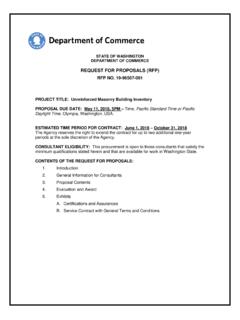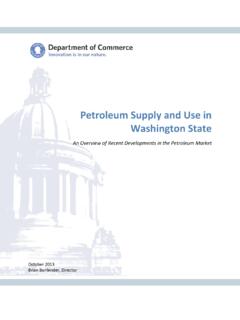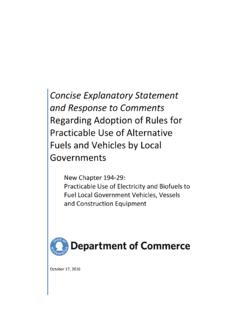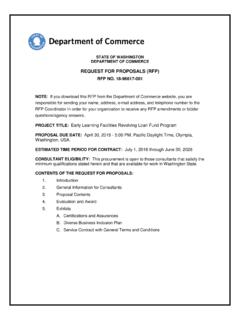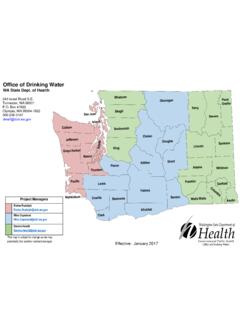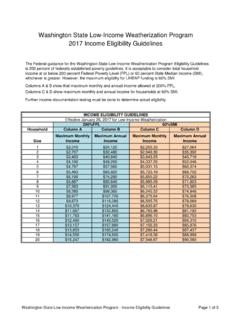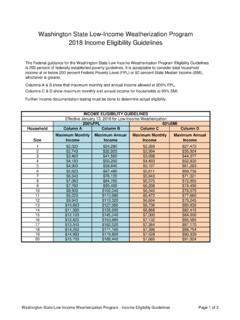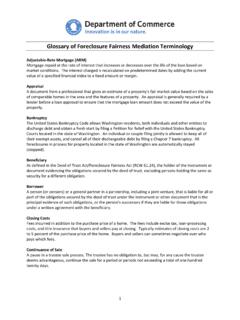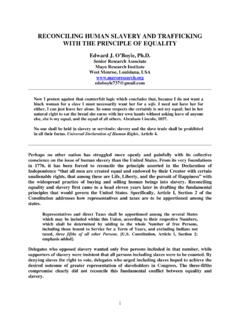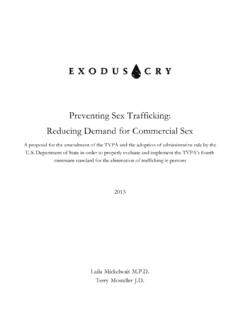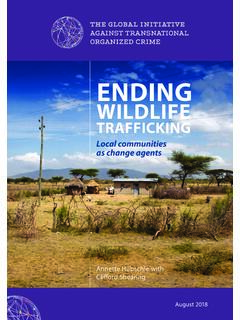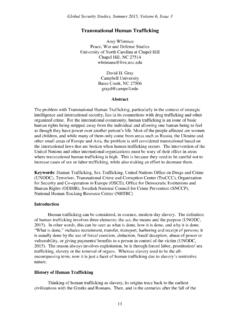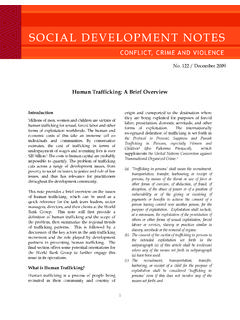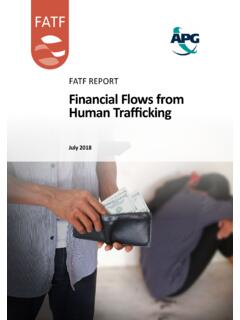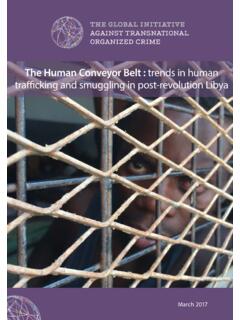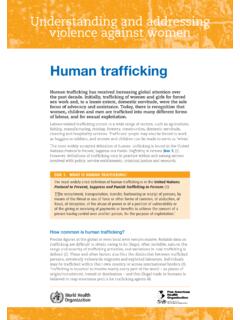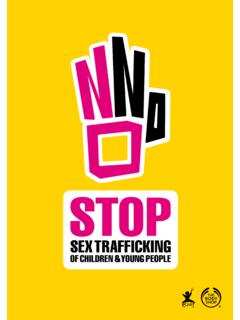Transcription of Washington State Task Force Report On Trafficking in Persons
1 Washington State Task Force Report On Trafficking in Persons November 2002 Office of Crime Victims Advocacy 906 Columbia Street, SW Box 48304 Olympia, Washington 98504-8304 To obtain this publication in an alternative format, please call (360) 725-2895 or TTY/TDD (800) 634-4473 or FAX (360) 586-7176. Table of Contents Executive Summary i Recent History 1 Defining the Trafficking Problem 3 Trafficking Victim Assistance and Prevention: Current Limitations 7 Identifying Victim Services 10 Recommendations for Trafficking Victims Support and Assistance 12 Conclusion 14 Appendix: Task Force Survey 15 Integration of the Human Rights of Women and the Gender Perspective: Report of the Special Rapporteur on Violence Against Women, United Nations, 2000.
2 17 Participants in the Washington State Anti- Trafficking Task Force 50 iExecutive Summary Washington State is leading the country in taking collaborative action against human Trafficking , a practice also known as modern day slavery. Legislators, activists and researchers have worked side by side to adopt anti- Trafficking legislation and establish the first statewide Anti- Trafficking Task Force in the United States. This Report also highlights the efforts of State and community representatives and other members of the Task Force to measure and evaluate State anti- Trafficking activities, identify services available to trafficked Persons at local, State and federal levels, and make recommendations for a coordinated system of care for trafficked Persons .
3 This Report provides background information, placing the problem in both a global and local context. Trafficking in Persons enslaves approximately four million Persons worldwide. An estimated 45,000-50,000 women and children, and an unknown number of men, are trafficked into the United States every year. Thus, human Trafficking has tremendous implications for both governmental and non-governmental entities and impacts Americans and the global community alike. In an effort to combat Trafficking in Persons , the United States government enacted the Trafficking Victims Protection Act (TVPA) of 2000, a three-pronged strategy of prevention, prosecution, and protection.
4 Washington State has taken additional steps to prevent Trafficking through regulation of the international matchmaking industry. However, based on a preliminary survey conducted by members of the Task Force , protection and assistance to trafficked Persons is impeded by a lack of funds and limited resources among service agencies within the State . Based on the Task Force s findings, recommendations for the Governor and State Legislature are divided into three broad categories: Policy, Services, and Training and Education. The Task Force also recommends the Legislature fund and continue to support the Task Force , so that it may carry on its original mandate to evaluate and monitor the State s progress in Trafficking -related activities and help develop a coordinated system of care for trafficked Persons .
5 In addition to these recommendations, community agencies and service providers on the Task Force express their commitment to continue to seek solutions through federal funding opportunities and to cooperate in prevention and prosecution efforts facilitated by membership on the Task Force . ii 1 Recent History Washington State is leading the country in taking collaborative action against human Trafficking , a practice also known as modern day slavery. Legislators, activists and researchers have worked side by side to adopt anti- Trafficking legislation and establish the first statewide Anti- Trafficking Task Force in the United States.
6 From June to November 2002, Task Force members set out to meet three goals: 1) measure and evaluate the State s progress in Trafficking -related activities; 2) identify available services to trafficked Persons at the local, State , and federal levels; and 3) recommend methods to provide a coordinated system of support for Persons who are victims of Trafficking . Grassroots mobilization, particularly from the Washington Filipino-American Community, made legislation and statewide action possible. A number of high-profile Trafficking cases served as a catalyst to these efforts. In 1990, Filipina Helen Clemente was forced into a sham marriage arranged by Eldon Doty, an ex-Seattle police officer, and his wife Sally Doty.
7 She was forced into indentured servitude for the next three years while she worked as their In 1995, Timothy Blackwell murdered his wife, Susana Blackwell, and two of her friends in the King County Courthouse. Two weeks after the two married (arranged through an international matchmaking agency), Blackwell left her husband and sought legal protection for domestic In 2000, Anastasia King was murdered by her husband who had a prior history of domestic violence and abusive marriage by international She met her husband through the unregulated international matchmaking industry.
8 In 2000, Victor Nikolayevich Virchenko fraudulently recruited women and underage girls to perform Russian folk dances in Alaska. Upon arrival in Anchorage, he then forced them to dance nude in a strip Once law enforcement identified the victims, a number of them received services in Washington Also in 2000, law enforcement officials uncovered the movement of smuggled and trafficked Persons into the Port of Seattle. Over 200 victims received services in the Seattle In 1 Tu, Janet I. Spotlight on Trafficking of Women and Children, Seattle Times, November 13, 2001.
9 2 Haley, Jim. Brides, Mail to Order, APA Tribune: 3 Jamieson, Jr., Robert L. Suspect Threatened to Kill Previous Wife, Records Show, Seattle Post-Intelligencer, January 30, 2001. 4 Department of State website: 5 Survey respondent; September 2002. 6 Survey respondent; September 2002. 2 September of this year, investigators successfully broke up a criminal syndicate working nationwide, including various seaports along the West Finally in 2001, Kil-Soo Lee recruited more than 250 Vietnamese sweatshop laborers to work in American Many of those victims accessed services in the State of State Legislators responded to these incidents with action.
10 Representative Velma Veloria and Senator Jeri Costa introduced Anti- Trafficking legislation, and Senator Jeanne Kohl-Welles introduced legislation to regulate the international matchmaking industry. The Trafficking in Persons Act (HB 2381) created the State Task Force Against Trafficking . The Mail Order Bride Act (SB 6412) required international matchmaking agencies to provide criminal and marital background information on the person from Washington State using the agency to meet prospective Both pieces of legislation were overwhelmingly supported in the Washington Legislature.
